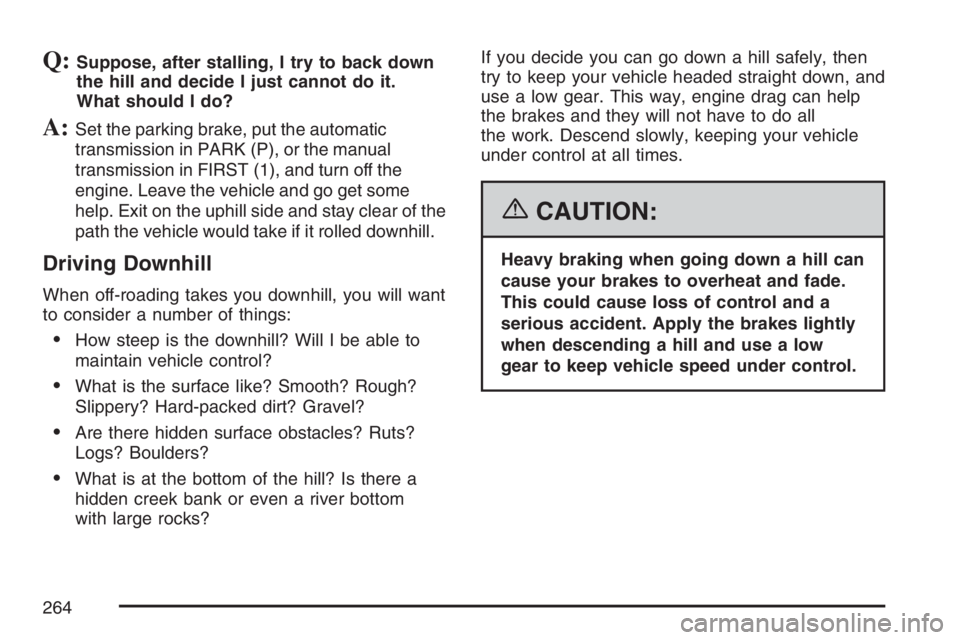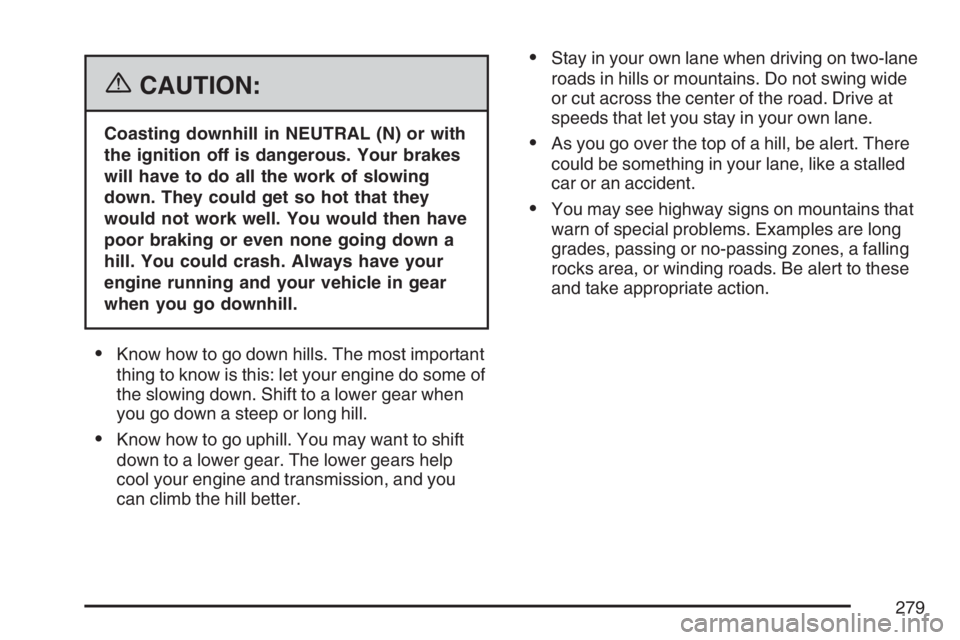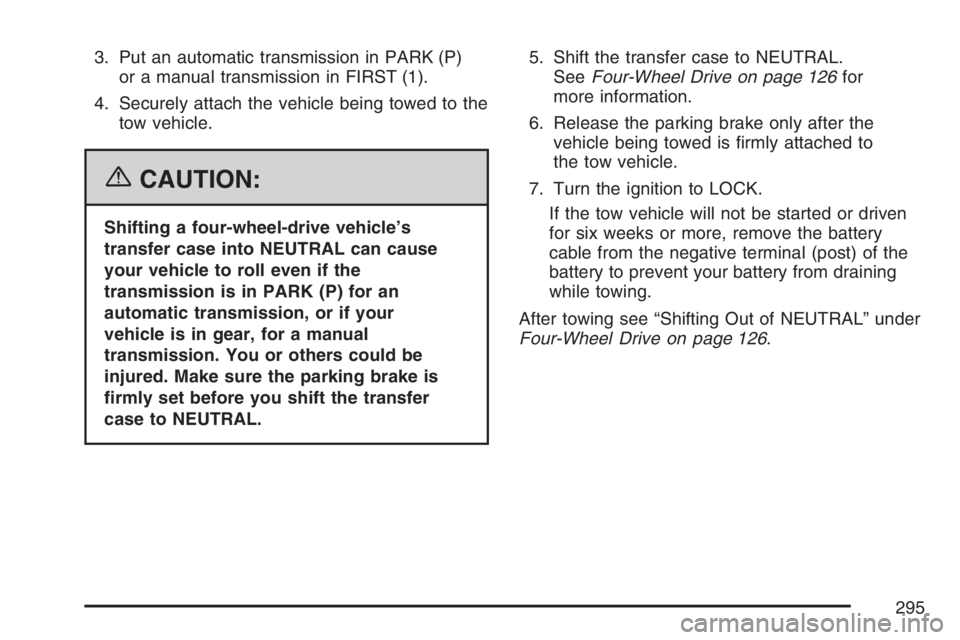Page 263 of 492

Q:What should I do if my vehicle stalls,
or is about to stall, and I cannot make it
up the hill?
A:If this happens, there are some things you
should do, and there are some things you
must not do. First, here is what youshoulddo:
Push the brake pedal to stop the vehicle and
keep it from rolling backwards. Also,
apply the parking brake.
If your engine is still running, shift the
transmission to REVERSE (R), release the
parking brake, and slowly back down the hill
in REVERSE (R).
If your engine has stopped running, you will
need to restart it. With the brake pedal pressed
and the parking brake still applied, shift the
transmission to PARK (P), or shift to NEUTRAL
if your vehicle has a manual transmission, and
restart the engine. Then, shift to REVERSE (R),
release the parking brake, and slowly back
down the hill as straight as possible in
REVERSE (R).
As you are backing down the hill, put your left
hand on the steering wheel at the 12 o’clock
position. This way, you will be able to tell ifthe wheels are straight and maneuver as
you back down. It is best that you back down
the hill with the wheels straight rather than in
the left or right direction. Turning the wheel too
far to the left or right will increase the possibility
of a rollover.
Here are some things youmust notdo if you stall,
or are about to stall, when going up a hill.
Never attempt to prevent a stall by shifting
into NEUTRAL (N), or pressing the clutch
if your vehicle has a manual transmission,
to rev-up the engine and regain forward
momentum. This will not work. Your vehicle
will roll backwards very quickly and you
could go out of control.
Instead, apply the regular brake to stop
the vehicle. Then apply the parking brake.
Shift to REVERSE (R), release the parking
brake, and slowly back straight down.
Never attempt to turn around if you are
about to stall when going up a hill. If the hill
is steep enough to stall your vehicle, it is
steep enough to cause you to roll over if you
turn around. If you cannot make it up the
hill, you must back straight down the hill.
263
Page 264 of 492

Q:Suppose, after stalling, I try to back down
the hill and decide I just cannot do it.
What should I do?
A:Set the parking brake, put the automatic
transmission in PARK (P), or the manual
transmission in FIRST (1), and turn off the
engine. Leave the vehicle and go get some
help. Exit on the uphill side and stay clear of the
path the vehicle would take if it rolled downhill.
Driving Downhill
When off-roading takes you downhill, you will want
to consider a number of things:
How steep is the downhill? Will I be able to
maintain vehicle control?
What is the surface like? Smooth? Rough?
Slippery? Hard-packed dirt? Gravel?
Are there hidden surface obstacles? Ruts?
Logs? Boulders?
What is at the bottom of the hill? Is there a
hidden creek bank or even a river bottom
with large rocks?If you decide you can go down a hill safely, then
try to keep your vehicle headed straight down, and
use a low gear. This way, engine drag can help
the brakes and they will not have to do all
the work. Descend slowly, keeping your vehicle
under control at all times.
{CAUTION:
Heavy braking when going down a hill can
cause your brakes to overheat and fade.
This could cause loss of control and a
serious accident. Apply the brakes lightly
when descending a hill and use a low
gear to keep vehicle speed under control.
264
Page 265 of 492

Q:Are there some things I should not do
when driving down a hill?
A:Yes! These are important because if you
ignore them you could lose control and
have a serious accident.
When driving downhill, avoid turns that take
you across the incline of the hill. A hill that
is not too steep to drive down may be
too steep to drive across. You could roll over
if you do not drive straight down.
Never go downhill with the transmission in
NEUTRAL (N), or with the clutch pedal pressed
down with a manual transmission. This is called
“free-wheeling.” The brakes will have to do all
the work and could overheat and fade.
Q:Am I likely to stall when going downhill?
A:It is much more likely to happen going uphill. But
if it happens going downhill, here is what to do.
1. Stop your vehicle by applying the regular
brakes. Apply the parking brake.
2. Shift to PARK (P), or to NEUTRAL with the
manual transmission, and, while still braking,
restart the engine.3. Shift back to a low gear, release the parking
brake, and drive straight down.
4. If the engine will not start, get out and
get help.
Driving Across an Incline
Sooner or later, an off-road trail will probably go
across the incline of a hill. If this happens,
you have to decide whether to try to drive across
the incline. Here are some things to consider:
A hill that can be driven straight up or
down may be too steep to drive across. When
you go straight up or down a hill, the length
of the wheel base — the distance from
the front wheels to the rear wheels — reduces
the likelihood the vehicle will tumble end
over end. But when you drive across
an incline, the much more narrow track
width — the distance between the left and
right wheels — may not prevent the vehicle
from tilting and rolling over. Also, driving
across an incline puts more weight on
the downhill wheels. This could cause a
downhill slide or a rollover.
265
Page 278 of 492
Hill and Mountain Roads
Driving on steep hills or mountains is different
from driving in �at or rolling terrain.If you drive regularly in steep country, or if you are
planning to visit there, here are some tips that
can make your trips safer and more enjoyable.
SeeOff-Road Driving on page 256for information
about driving off-road.
Keep your vehicle in good shape. Check all
�uid levels and also the brakes, tires, cooling
system, and transmission. These parts can
work hard on mountain roads.
{CAUTION:
If you do not shift down, your brakes
could get so hot that they would not work
well. You would then have poor braking or
even none going down a hill. You could
crash. Shift down to let your engine assist
your brakes on a steep downhill slope.
278
Page 279 of 492

{CAUTION:
Coasting downhill in NEUTRAL (N) or with
the ignition off is dangerous. Your brakes
will have to do all the work of slowing
down. They could get so hot that they
would not work well. You would then have
poor braking or even none going down a
hill. You could crash. Always have your
engine running and your vehicle in gear
when you go downhill.
Know how to go down hills. The most important
thing to know is this: let your engine do some of
the slowing down. Shift to a lower gear when
you go down a steep or long hill.
Know how to go uphill. You may want to shift
down to a lower gear. The lower gears help
cool your engine and transmission, and you
can climb the hill better.
Stay in your own lane when driving on two-lane
roads in hills or mountains. Do not swing wide
or cut across the center of the road. Drive at
speeds that let you stay in your own lane.
As you go over the top of a hill, be alert. There
could be something in your lane, like a stalled
car or an accident.
You may see highway signs on mountains that
warn of special problems. Examples are long
grades, passing or no-passing zones, a falling
rocks area, or winding roads. Be alert to these
and take appropriate action.
279
Page 284 of 492

If Your Vehicle is Stuck in Sand,
Mud, Ice, or Snow
In order to free your vehicle when it is stuck,
you will need to spin the wheels, but you do not
want to spin your wheels too fast. The method
known as rocking can help you get out when you
are stuck, but you must use caution.
{CAUTION:
If you let your vehicle’s tires spin at high
speed, they can explode, and you or others
could be injured. And, the vehicle can
overheat. That could cause an engine
compartment �re or other damage. When
you are stuck, spin the wheels as little as
possible. Do not spin the wheels above
35 mph (55 km/h) as shown on the
speedometer.Notice:Spinning the wheels can destroy
parts of your vehicle as well as the tires. If you
spin the wheels too fast while shifting the
transmission back and forth, you can destroy
the transmission.
For information about using tire chains on your
vehicle, seeTire Chains on page 392.
Rocking Your Vehicle to Get It Out
First, turn the steering wheel left and right. That will
clear the area around the front wheels. If you have
a four-wheel-drive vehicle, shift into 4HI. If your
vehicle has traction control, turn the traction control
system off. SeeTraction Control System (TCS)
on page 249. Then shift back and forth between
REVERSE (R) and a forward gear, or with a manual
transmission, between FIRST (1) or SECOND (2)
and REVERSE (R), spinning the wheels as little as
possible. Release the accelerator pedal while you
shift, and press lightly on the accelerator pedal
when the transmission is in gear. By slowly spinning
the wheels in the forward and reverse directions,
you will cause a rocking motion that may free
your vehicle.
284
Page 294 of 492
Dinghy Towing
Two-Wheel Drive Vehicles
Notice:If you tow your vehicle with all
four wheels on the ground, the drivetrain
components could be damaged. The repairs
would not be covered by your warranty.
Do not tow your vehicle with all four wheels
on the ground.
Two-wheel-drive vehicles should not be towed with
all four wheels on the ground. Two-wheel-drive
transmissions have no provisions for internal
lubrication while being towed.
Four-Wheel Drive Vehicles
Use the following procedure to tow your vehicle
with all four wheels on the ground:
1. Drive the vehicle to be towed into position
behind the tow vehicle.
2. Firmly set the parking brake. SeeParking
Brake on page 130for more information.
294
Page 295 of 492

3. Put an automatic transmission in PARK (P)
or a manual transmission in FIRST (1).
4. Securely attach the vehicle being towed to the
tow vehicle.
{CAUTION:
Shifting a four-wheel-drive vehicle’s
transfer case into NEUTRAL can cause
your vehicle to roll even if the
transmission is in PARK (P) for an
automatic transmission, or if your
vehicle is in gear, for a manual
transmission. You or others could be
injured. Make sure the parking brake is
�rmly set before you shift the transfer
case to NEUTRAL.5. Shift the transfer case to NEUTRAL.
SeeFour-Wheel Drive on page 126for
more information.
6. Release the parking brake only after the
vehicle being towed is �rmly attached to
the tow vehicle.
7. Turn the ignition to LOCK.
If the tow vehicle will not be started or driven
for six weeks or more, remove the battery
cable from the negative terminal (post) of the
battery to prevent your battery from draining
while towing.
After towing see “Shifting Out of NEUTRAL” under
Four-Wheel Drive on page 126.
295